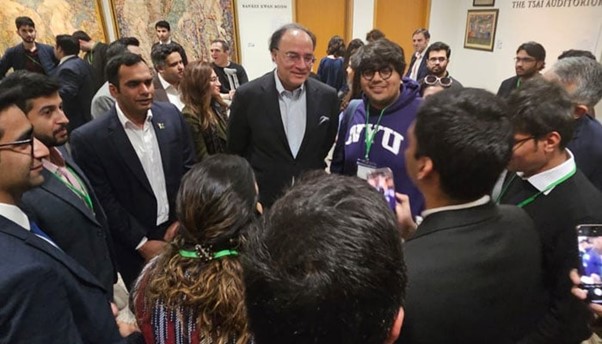Speaking at Harvard University, Finance Minister Muhammad Aurangzeb showcased the impressive Pakistan Economic Growth. He invited global investors to explore new opportunities in the country.
During the “Bridging Divides, Building Tomorrow: Pakistan’s Path to Inclusive Growth and Governance” conference, Aurangzeb outlined how Pakistan turned around its struggling economy. The event served as a major forum, connecting policymakers, academics, business leaders, and students to discuss Pakistan’s economic, political, and social journey.
Aurangzeb stated that the government inherited serious economic troubles, including a shrinking GDP and falling reserves. However, he said the administration had stabilised the basics, restored investor confidence, and re-ignited growth.
He proudly shared major achievements under the government’s watch. Inflation dropped to just 0.7%, the lowest in 60 years. Pakistan’s foreign exchange reserves doubled. The national currency appreciated by 3%. The current account surplus exceeded $1 billion in March 2025.
Aurangzeb further underlined the country’s strong Pakistan Economic Growth by mentioning a 44% surge in Foreign Direct Investment (FDI). Information Technology (IT) exports also rose by 24%. Meanwhile, remittances hit an all-time high, projected at $38 billion.
For the first time in 24 years, Pakistan posted a fiscal surplus. Moreover, the primary fiscal surplus reached its highest point in two decades. Fitch Ratings upgraded Pakistan’s sovereign credit rating to B- with a stable outlook, boosting market confidence.
The finance minister stressed that economic stability is not the ultimate goal but a stepping stone. He shared the government’s blueprint focusing on fiscal discipline, inflation control, and structural reforms in key sectors. These include energy, taxation, governance, and state-owned enterprise management.
Highlighting future growth areas, Aurangzeb mentioned Pakistan’s mineral wealth, the booming IT sector, and new green energy initiatives. He also praised the country’s young and dynamic entrepreneurs. He emphasized that investing in human development is key to long-term Pakistan Economic Growth.
On debt management, Aurangzeb explained how Pakistan successfully reduced its public debt-to-GDP ratio from 75% to 67.2%. The plan is to cut it further below 60% over the medium term. This will be done through smart fiscal policies, better domestic financing, and sweeping tax reforms.
He added that rightsizing government spending and privatising loss-making enterprises could save up to 2% of GDP annually. Transparency, competitive bidding, and investor trust will be the core principles behind these efforts.
Talking about Pakistan’s financial sector, Aurangzeb laid out plans for a deeper and more resilient system. Digital banking, robust capital markets, and green finance will be key pillars of this expansion.
The finance minister also addressed climate change. He reaffirmed Pakistan’s strong commitment to building resilience into infrastructure and agriculture. He highlighted the Resilience and Sustainability Facility (RSF) from the IMF and the World Bank’s Country Partnership Programme (CPF) as major support systems.
Ending his speech on an optimistic note, Aurangzeb said Pakistan’s future depends on bold and necessary reforms. By investing in people, modernising the economy, and staying committed to reforms, he assured that Pakistan Economic Growth will lead the country to become stronger, greener, and more competitive.


